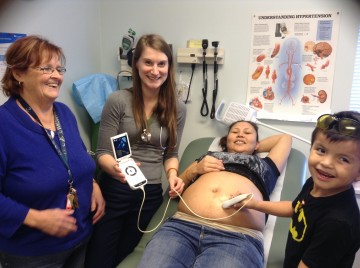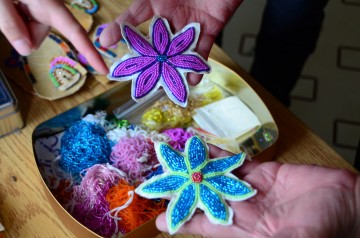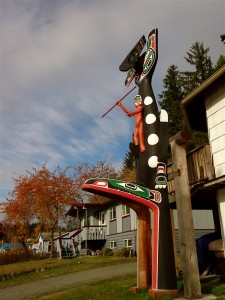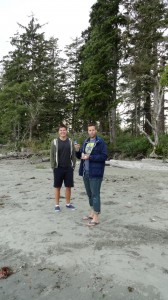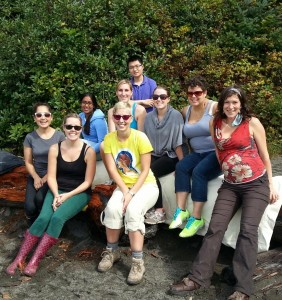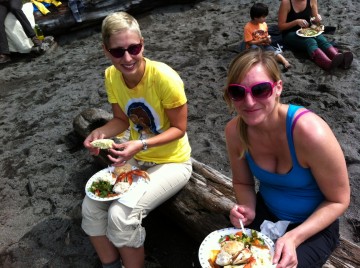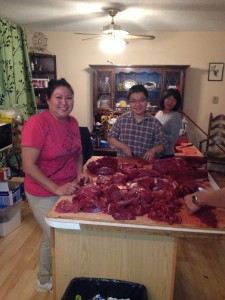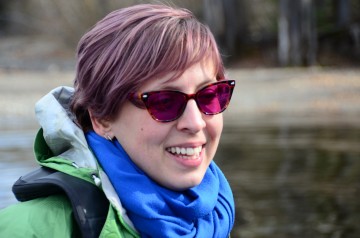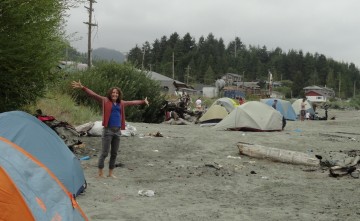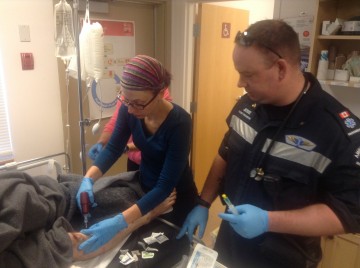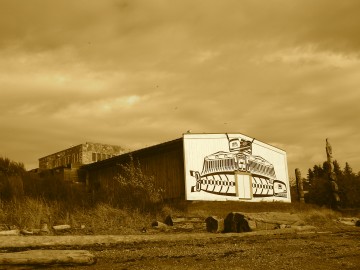Site Director Message
Welcome to the Indigenous Family Medicine Site. We are focused on training family physicians who have a strong interest in working with and for Indigenous peoples in ways that transform health care practices and systems.
Our program welcomes both Indigenous and non-Indigenous residents with a focus in anti-racist approaches to care. Our residents gain unique advocacy skills to help address the effects of historical, geographic and political factors that impact the health status of Indigenous people in Canada.Graduates from our program enter practice as competent well-rounded family physicians who provide care in multiple settings, with the ultimate goal of improving health for Indigenous patients and communities.
Healthy relationships are critical to supporting healthy individuals and communities and in recognition of this our program focuses on building strong relationships between our residents, Indigenous communities, Elders, and site faculty. We are deeply respectful of Indigenous ways of knowing and as such incorporate traditional teachings and ceremony into our various academic activities.
Our residents have opportunities to work in some of the most spectacular Indigenous territories in BC and elsewhere. If you are someone who is interested in approaching Family Medicine from a unique perspective, are eager to work for Indigenous communities, and like the appeal of a close-knit program with a focus on relationship, we look forward to welcoming you to our site!
Dr. Morgan Lindsay and Dr. Chelsea Monell
Co-Site Directors
Lead Resident Message
Our program is grounded in Indigenous ways of knowing and trauma informed care. We are Elder-led and value a two-eyed approach to medicine. We are looking for residents that want to integrate Western medicine with Indigenous values and ways of knowing. All our sites focus on social justice and reconciliation in a medical context. Whether Indigenous or not, if this is the lens you see medicine through, we encourage you to apply.
We are the first Family Medicine Residency site in Canada with a specific focus on Indigenous Peoples’ health and wellness. Comprised of residents, preceptors, clinics, and communities with dedication, passion, and expertise, this site provides a unique and unparalleled program. We are a small, flexible, and supportive program where residents have the opportunity to identify their own learning and professional goals, within the larger context and backing of the UBC Family Medicine Residency Program. Our site provides residents with a flexible platform to learn holistic healthcare and Indigenous approaches to medicine on the backdrop of the UBC comprehensive western curriculum.
Our site allows for a mix of both urban and rural placements, with the unifying thread of caring for Indigenous patients in our home clinics and in the community. When applying to our program, we have two separate streams: Vancouver and Vancouver Island. Our mainland site is based in Vancouver (in particular, the Downtown Eastside), but also involves outreach to remote Indigenous communities in Northern BC. Our island sites include Victoria, Cowichan, and Ladysmith, which present a mixture of urban and rural opportunities as well as community outreach to neighbouring Indigenous communities. There is an internal ranking of these sites once matched to Vancouver Island. In addition to the 2 blocks of rural medicine in second year (or longer if extended option pursued), all residents will complete a block of rural medicine in their first year in Alert Bay or other remote Indigenous communities. There are further opportunities to pursue outreach work in rural and remote Indigenous communities, such as Carrier Sekani Family Services.
For the longitudinal academic curriculum, each distributed site is partnered with a sister site in the geographic vicinity — St. Paul’s, Victoria, and Nanaimo sites. These academic sessions review key Family Medicine topics, through either academic half days or Nanaimo’s periodic academic weeks.
An exciting opportunity that is unique to our site is the Indigenous site-specific academic days, which are two consecutive call-protected days every three months that we spend in community and with Elders receiving cultural-based and traditional teachings. These days are often hosted within First Nations communities with whom each sub-site has partnered . They involve community engagement, development of reciprocity and relationship, and traditional ways of sharing knowledge. Academic Days are treasured opportunities for us to come together to develop our own professional cultural humility, and are always viewed as personally grounding, refreshing, and fun-packed experiences.
In summary, the UBC Indigenous Family Medicine Site encompasses and reflects reconciliation, excellence in healthcare knowledge, and a harmonized approach to medicine. Most importantly, we have fun doing it! We look forward to hearing from you and answering any questions you may have.
Co-Lead Residents
Dr. Yotakahron Jonathan and Dr. Teila Wiese
Number of Residents: 7
Locations: Distributed training sites include Vancouver’s Downtown East Side – 3 Residents, Vancouver Island (Ladysmith, Victoria and Cowichan) – 4 Residents
Community: various, as above
Hospitals: Royal Jubilee, Victoria General Hospital, St. Paul’s, Cowichan District Hospital, Nanaimo General Hospital, and Saanich Peninsula Hospital
Distance from Vancouver to Vancouver Island- Victoria: 116 KM
Curriculum Type: Partial Horizontal
R2 Elective Time: 10-14 Weeks
Contacts: Co-Site Director – Dr.Morgan Lindsay, Co-Site Director- Dr. Chelsea Monell, Coordinator – Carlea Remodo
Lead Resident: Lead Resident Vancouver Mainland- Dr. Teila Wiese & Lead Resident Vancouver Island- Dr. Yotakahron Jonathan
Overview
A main objective of our site is to have graduates be aware of the specific needs of Indigenous peoples and to be a resource for anyone working with this community. We offer a small family feel site with a focus on resident well-being through sharing circles, Elder support and community engagement.
In order to enhance the amount of time spent in Indigenous communities, our site transitioned to a distributed site in July 2013 and in 2015 we will be offering 2 separate match sites: Vancouver Island and Vancouver Urban. As each site offers unique educational opportunities, a sample curriculum follows; however specific curricula vary slightly from site to site. Both sites offer educational experiences to meet accreditation standards.
Additional Curricula
Due to our small size (i.e. 2 – 4 residents per geographic site), our sites collaborate with other UBC Family Practice Residency Program sites to deliver academic curricula. Indigenous site residents participate in the local academic curriculum of their partner UBC Family Practice site.
Indigenous Educational Experiences
In addition to the variety of experiences residents have within their home base community, the full complement of Indigenous Site residents meet bi-monthly for Indigenous academic days. We gather face to face in our Indigenous home base communities to learn from Elders and participate in local activities for 1.5 days. The first half-day will focus on site governance and the second day is to honor and celebrate Indigenous approaches to health and healing. Indigenous academic days also offer an opportunity to reconnect and share stories about the successes and challenges in working in the area of Indigenous health and also to consolidate teachings about cultural safety.
Matches
Successful applicants are matched to an Indigenous community site in either Vancouver or on Vancouver Island. Due to the unique nature of our site, we encourage you to contact Carlea Remodo – Site Coordinator (cremodo@uvic.ca) for up to date information regarding Indigenous site specifics.
Program Highlights
- The mission of the UBC Indigenous Program is to improve the health of Indigenous people of British Columbia by training Indigenous and other family physicians sensitive to and empowered with skills and knowledge of Indigenous health issues.
- You do not need to be Indigenous to be selected but you need to have a desire to work with the Indigenous population
- Focus on Indigenous patients in Family Medicine and elective rotations with 1 month Family Medicine rotation in Alert Bay during R1 for Vancouver Island-based learners and several one week rural fly-in opportunities for Vancouver based learners
- Opportunities for interaction with Elders and Elder support, Indigenous physicians and community visits are incorporated into academic sessions
- Attend Indigenous conferences and workshops where registration fee may be covered
- Understanding health in the context of the medicine wheel as well as other Indigenous paradigms for health
- Incorporate traditional healing practices and beliefs as well as an understanding of the importance of these practices to many First Nations
- Program is evolving, and residents can help shape its future as we build further opportunities to train with Indigenous patient populations
- Family feel – small flexible and supportive training site.
Sample Rotation
| Block 1 | Block 2 | Block 3 | Block 4 | Block 5 | Block 6 | Block 7 | Block 8 | Block 9 | Block 10 | Block 11 | Block 12 | Block 13 | |
| R1 | Intro to FP | Peds | CTU | Vac/ Elec |
FP/OB | FP/OB | FP/OB | Rural FN Health | ER | Vac/ Elec |
CCU-CTU | FP/OB | FP/OB |
| R2 | Elec | Elec | Pall | FM/ Ortho | FM/Elec | FM/Psych | CFM | FM/Ele | Surg | Elec | Rural | Rural | Trans to Practice |
Program Curriculum – Vancouver Island
This site provides opportunities to develop special expertise in Indigenous health for both Indigenous and non-Indigenous physicians. Please note that this site also includes residents based at Indigenous – Mainland Vancouver however it is included in a separate CaRMS match.
Our program is relationship-based and engaged with Indigenous communities. We work in collaboration with a number of Indigenous communities and their health care teams to provide educational experiences whereby residents are connected with an Indigenous community for the duration of their training. Over the course of their training residents develop relationships with specific Indigenous individuals, families and their community and see these same clients and their extended family networks in a variety of care settings (ie. primary care clinic, in-hospital etc.). The residents are welcomed and encouraged to participate in community activities and gatherings in order to help them develop trust with the community they are serving. Our program focuses on supporting residents to engage with communities in a respectful way in order to learn about health and healing with and from Indigenous peoples.
In order to enhance the amount of time spent in Indigenous communities, our site has adopted a distributed model. We have residents placed in Victoria, Duncan and Ladysmith and we are looking to expand to other communities. All of our residents also gain experience in remote Indigenous health in either one month community based rotations or one week a month fly-in experiences. Each site offers unique educational opportunities, and as such specific curricula vary slightly from site to site. Our sites have embraced longitudinal curricula that maximize residents’ continuity of care. All sites offer educational experiences to meet accreditation standards.
Curriculum Sample – *Please note that these vary site to site
| R1 | Duration | Location/Notes |
| FP with longitudinal components | 20-24 weeks | FP block time based in a family medicine clinic that serves a large number of Indigenous clients. Longitudinal training opportunities are specific to each Indigenous community. (Ie. Peds, OB, Psych) |
| Rural FN FP Rotations | 4 weeks | Residents will spend 4 weeks in Alert Bay working with the ‘Namgis First Nations |
| Care of Children and Adolescents | 4 weeks | ** |
| Care of Women/Maternity health | 4 weeks | ** |
| Electives | 8 weeks | ** |
| Care of Adults – IM or Psych | 4 weeks | ** |
| Critical Care – ER | 4 weeks | ** |
| R2 | Duration | Location/Notes |
| Family Practice with longitudinal | ~30 weeks | FP block time includes time based in an Indigenous health clinic. Longitudinal training opportunities are specific to each Indigenous community (Ie. Peds, OB, Psych) |
| Rural Family Practice | 8 weeks | ** |
| Palliative | 2-4 weeks | ** |
| General Surgery | 3 weeks | Saanich Peninsula Hospital |
| Elective block | 8 weeks | Potential for international electives |
Training Sites
**In-hospital educational experiences will occur in the following hospitals depending on a resident’s home-base; Victoria – Royal Jubilee Hospital, Duncan – Cowichan District Hospital & Nanaimo Regional General Hospital, Ladysmith – Nanaimo Regional General Hospital.
Internal matches
Successful applicants are internally matched to a community on Vancouver Island – Victoria, Duncan or Ladysmith. Every effort is made to accommodate the candidate’s first choice community. Due to the unique nature of our site we encourage you to contact Carlea Remodo – Site Coordinator (cremodo@uvic.ca) for up to date information regarding Indigenous site specifics.
Program Curriculum – Mainland Vancouver
This site provides opportunities to develop special expertise in Indigenous health for both Indigenous and non-Indigenous physicians. Please note that this site also includes residents based at Indigenous – Vancouver Island. Information regarding Indigenous – Vancouver Island can be found under a separate CaRMS description.
Our program is relationship-based and engaged with Indigenous communities. We work in collaboration with a number of Indigenous communities and their health care teams to provide educational experiences whereby residents are connected within an Indigenous community for the duration of their training. Over the course of their training residents develop relationships with specific Indigenous individuals, families and their community and see these same clients and their extended family networks in a variety of care settings (ie. primary care clinic, in-hospital etc.). The residents are welcomed and encouraged to participate in community activities and gatherings in order to help them develop trust with the community they are serving. Our program focuses on supporting residents to engage with communities in a respectful way in order to learn about health and healing with and from Indigenous peoples.
In order to enhance the amount of time spent in Indigenous communities, our site has adopted a distributed model. We have residents placed across BC, including Vancouver’s Downtown Eastside in the Indigenous – Mainland Vancouver site. The primary clinical sites for our Indigenous – Mainland Vancouver residents are Vancouver Native Health Society, Urban Indigenous Health and Healing Cooperative, Lu’Ma Medical Clinic and Sheway. All of our residents also gain experience in remote First Nations health which is unique to our site. Our clinical sites incorporate longitudinal curriculums that maximize residents’ continuity of care. All sites offer educational experiences to meet accreditation standards.
Curriculum Sample
| R1 | Duration | Location/Notes |
| Family Practice | 24 weeks | Horizontal time includes clinics in FM, maternity care, care of children/adolescents and psych, also includes OB call and WARD call |
| First Nations FP | 4 weeks | 4 x one week fly-in visits to Carrier Sekani territories throughout horizontal family practice |
| Elective | 4 weeks | |
| OB/Gyn | 4 weeks | BCWH Family Medicine Obstetrics call group |
| ER or Ward | 8 weeks | St. Paul’s Hospital |
| Pediatrics | 4 weeks | Selective (can be done out of province) |
| IM-CTU | 4 weeks | St. Paul’s Hospital or Vancouver General Hospital |
| R2 | Duration | Location/Notes |
| Family Practice | 24 weeks | Horizontal time includes elective, remote FN community visits, care of elderly, psych. |
| Rural Family Practice | 8 weeks | |
| Ward or ER | 4 weeks | St. Paul’s Hospital/ Burnaby Hospital |
| Surgery | 3 weeks | Saanich Peninsula Hospital ( Victoria) |
| Palliative | 2 weeks | St. Paul’s Hospital or St. Johns Hospice (UBC) |
| Elective | 12 weeks |
Training Sites
Vancouver Native Health Society – Vancouver Native Health Society (VNHS) was established in 1991 with a mission to improve and promote the health of individuals with a focus on the Aboriginal community residing in Greater Vancouver. Today, Vancouver Native Health Society delivers comprehensive medical, counselling and social services generally to Vancouver’s Downtown Eastside Aboriginal community. The majority of VNHS clients struggle with overlapping issues and concurrent health issues such as substance abuse, mental health, chronic disease, homelessness and poverty.
Sheway – Sheway is a Pregnancy Outreach Program (P.O.P.) located in the Downtown Eastside of Vancouver. The program provides health and social service supports to pregnant women and women with infants under eighteen months who are dealing with drug and alcohol issues. The focus of the program is to help the women have healthy pregnancies and positive early parenting experiences.
Lu’Ma Medical Centre – Located within Lu’Ma Native Housing Society. The Lu’Ma clinic provides safe, culturally integrated health care that is accessible to families to increase positive health outcomes and remove disparities. The clinic offers a smudging area and medicine bag making materials as well as access to traditional healers and Elders.
Urban Indigenous Health and Healing Cooperative (UIHHC) – a collaboration between Indigenous Elders, physicians and allied health professionals to provide a safe and healing space for the Indigenous and non-Indigenous community in Vancouver’s Downtown Eastside. This centre will be opening in the fall of 2018, to provide care to over 3000 individuals of all nations who face the challenges of inner-city living.
St. Paul’s Hospital – Home of one of only two active Family Practice teaching wards in Canada, modeling comprehensive and continuous care in a metropolitan setting. Majority of primary care inpatient and specialist training takes place at St. Paul’s Hospital, a tertiary referral hospital of 480 beds including Family Practice Ward, Obstetrics, and a very busy Emergency Department. St. Paul’s has been a teaching hospital for residents and interns for over 70 years and has a proud reputation for the quality of its teaching programs.
A day in the life of a Vancouver Indigenous Site Resident
R1
The R1 curriculum has been adapted over the past year based on resident input, and because this is still a new site, it may change further. The residency starts off with the “Foundations of Family Medicine” block with our St. Paul’s Hospital sister site. This is an entire month free of call (!) with an emphasis on getting oriented to residency, as well as a focus on Behavioral Medicine. It is a lovely time to get to know the SPH residents who, in addition to the Aboriginal Site residents, will become your resident family.
Next, residents spend 3 months doing longitudinal Family Medicine, either based at Vancouver Native Health Society clinic/Urban Indigenous Health and Healing Cooperative/Lu’Ma Medical Clinic or at Sheway. The resident based at VNHS/UIHHC/Lu’Ma whereas the resident based at Sheway does rounds on FIR square and on-call with the Family Practice obstetrics call group at BC Women’s Hospital. After 3 months, the residents switch primary sites. These 3 month longitudinal sessions have provided a level of continuity with patients and clinics that is difficult to attain within a residency program, and which is beneficial both for the resident and the clients. In addition to the above longitudinal experiences, residents at VNHS/UIHHC/Lu’Ma will join Dr. John Pawlovich in monthly visits to five small reserve communities in north central BC, where residents get valuable in-community experience and practice full-scope remote family medicine.
The second half of R1 is spent doing core rotations in Internal Medicine, Obstetrics (with Family Practice Call group at BCWH), Family Medicine Ward, Emergency, Pediatrics and Electives. Most rotations, with the exception of Pediatrics and Obstetrics are done at St. Paul’s Hospital.
R2
The R2 curriculum is very resident driven. The required block rotations include a 2 week Palliative Care rotation, which is highly sought after and completed at SPH or St John’s hospice. There is also a mandatory Surgery rotation, which residents generally choose to complete in Sidney (just north of Victoria) because of the fantastic preceptor with whom we have established a relationship. While Surgery is considered to be a “problem” rotation in many Family Medicine Residency programs, we are proud to say that our residents have been consistently enthusiastic about completing their surgical rotations, and have ranked the surgical attending as one of the best teachers in the program for several years running. As with all residencies, there is a mandatory 2 month Rural rotation, which can be extended to 4 months at the residents request. However, for anyone interested, the opportunities to arrange rural electives are limitless and funding is available to cover transportation and accommodation through the Rural Education Action Plan (REAP). The remainder of R2 is made up of block and longitudinal electives, as well as longitudinal Family Medicine at our clinic sites. We as residents are able to reflect on our learning professional goals, and adjust our activities accordingly, both to fill in gaps in our learning, and to continue to grow professionally in a highly supportive environment.
A day in the life of a Victoria Resident
The Indigenous Family Medicine Victoria site is a unique blend of urban and rural medicine. I get all the amenities of city life, while having ample rural opportunities to practice more resource-restricted medicine. During my family medicine blocks, I work with a general family practitioner twice a week where I have the chance to build my bread and butter family medicine knowledge and skills. On Tuesdays, I am downtown, seeing a complex inner city population. This placement has helped me to understand the mammoth barriers facing people experiencing homelessness, substance use, and mental health challenges in an urban context. In contrast, I regularly get to serve more rural populations on reserve at Pacheedaht or Tsartlip. I then finish up my week at the Wellness Clinic at the Victoria Native Friendship Centre, where I work with the local, urban Indigenous folks. While this variety of placements felt daunting at first, I have come to really enjoy having so many different learning opportunities with so many knowledgeable, compassionate, and kind preceptors.
During my family medicine rotations, I also do house and labour & delivery overnight call shifts at the local hospitals, which allow me to improve my inpatient and perinatal care. My main Academic Half Days and off-service rotations are completed alongside the Victoria Family Medicine residents, many of whom have become close friends.
Every two months, our program has Indigenous Academic Half Days, during which we have had the opportunity to visit a variety of local communities on the island and in the lower mainland, and learn about each communities’ special health programs and needs, and how we might fit in as doctors. These retreats allow for bonding with my co-residents (including the bestowing of much-needed support and advice), as well as spending time in ceremony with our much beloved program elders.
These opportunities for cultural immersion encourage extensive reflection. They have strengthened our grasp of history and how it applies to today, including the interaction between western people, politics, and medicine, and Indigenous populations over the past 300 years and how we can move forward together with respect, understanding, and collaboration. This teaching, coupled with an excellent rural placement in Alert Bay, with a majority Indigenous population, have given me the skills and cultural competency I need to feel confident working as a doctor with Indigenous populations in remote or urban settings. If I had to do residency over again (hopefully that won’t happen!), I would not change a thing.
A day in the life of a Ladysmith Resident
A Day in the Life of a Ladysmith Resident:
“I am the current 2022-2024 resident at the Ladysmith site and having a wonderful experience!
When you are on your Family Practice blocks you will spend most of your days at the Hillside Clinic in Ladysmith, but there are opportunities to participate in care at either the Stz’uminus Health Centre with one of the Nurse Practitioners, or Snuneymuxw Hulit Lelum with one of the physicians who works there. Outside of your time at Hillside Clinic you have the opportunity to spend time at the Ladysmith Urgent Care Centre. Here you manage a variety of undifferentiated patients with full work up and management. It is an excellent place for learning, and you see everything from kiddos with ear infections, dislocated shoulders, to chest pain. You commonly see your patients from Hillside clinic in the Urgent care setting, allowing for increased continuity of care during your Family Practice blocks. My two preceptors, Dr. Swamy and Dr. Steeves are incredible teachers and keen to provide learning experiences wherever possible. I’ve listed an example of a typical week on family practice below:
Monday – Hillside Clinic Day (9 -5 PM)
Tuesday – Hillside Clinic Day (9 -5 PM)
Wednesday – Urgent Care (8-3 PM or 3-10 PM)
Thursday – Hillside Clinic Day (9 -5 PM)
Friday – Snuneymuxw Hulit Lelum (9 -5 PM)
Your rotations outside of your Family Practice blocks are located primarily in Nanaimo, Duncan and Victoria. Where you are depends on preference, but also preceptor and site related availability, as there are lots of wonderful learners on Vancouver Island. Depending on which site you work at you may be with other resident learners, or on your own with preceptors getting one on one teaching. For some of my off service I was located at the following sites:
Obstetrics – Victoria (other resident learners and medical students)
Pediatrics – Victoria (other resident learners and medical students)
Internal Medicine – Duncan (one on one with preceptor)
Emergency Medicine – Nanaimo (one on one with preceptor)
Addictions Medicine – Nanaimo (one on one with preceptor)
Another amazing aspect of the Ladysmith site is the involvement with the Nanaimo program and their residents. The Nanaimo program schedules their structured learning sessions into academic weeks instead of academic half days. It is nice to have connections to other learners close by and have learning weeks to connect and take a break from clinical work. The Indigenous Program meets 4 times each year for our own academic days (typically a Thursday and Friday) where we receive cultural teachings, spend time on the land and in community and connect with co-residents. We are a tight knit group despite the distance between each of our learning sites.
The Ladysmith site would be particularly well suited for a resident that is self-directed, comfortable with some movement for off-service rotations, wants to develop a wide scope of practice and enjoys working in a variety of settings.


